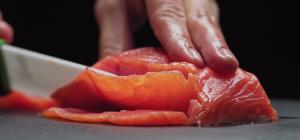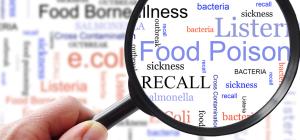
“Out of the box” food safety considerations for meal kits

Online shopping has provided a convenient option for consumers to procure products and services, one example of which is meal kits. Meal kits are boxes of perishable ingredients that are pre-portioned for a particular recipe that is then prepared and cooked at home. This direct-to-consumer model of delivering a combination of raw ingredients is unique to meal kit services and could introduce the potential for microbial contamination of the ingredients. This blog discusses the food safety implications of meal kits and provides information that can be communicated to manufacturers and consumers of meal kits by environmental health practitioners.
The rise in popularity of meal kits
Meal kit services can be ordered online, often as part of a subscription plan. Consumers are drawn to meal kits due to the convenience of not having to plan, shop for, or prepare ingredients. Consumers also report that portion control, reduced food waste, a variety of food options, more meaningful family meal times, and use of local food are key benefits of using meal kits. The start of the COVID-19 pandemic in 2020 and resulting restaurant closures also led to greater interest in meal kits by Canadian consumers. A Dalhousie University study of food habits during COVID-19 found that 12.8% of Canadians surveyed used meal kits in 2020 during the pandemic. It appears that even as in-person dining restrictions are lifted, Canadians are still interested in using meal kits, with 4.7% of Canadians surveyed indicating that they intend to purchase more meal kits in 2022.
The life cycle of a meal kit
While there is variation in manufacturing processes between meal kit services, in general, meal kits source a variety of raw ingredients from multiple suppliers and package those ingredients into a single container that is delivered directly to the consumer. The processing of a variety of ingredients in the same facility introduces the risk of cross-contamination between ingredients. The table below outlines the potential food safety risks at several common stages of the meal kit life cycle.
|
Stage of handling |
Potential food safety risks |
|
Ingredient sourcing |
|
|
Processing |
|
|
Transportation |
|
|
Consumer food handling |
|
The risk of microbial contamination
Meal kits are likely to contain a variety of foods that, in the absence of proper refrigeration, present a high risk for bacterial growth, such as raw meat products, eggs, and dairy. Other ingredients, such as raw produce, may be contaminated by pathogenic bacteria at the source facility or subject to cross-contamination during processing alongside raw meat ingredients. While rare, there have been incidents of microbial contamination of ingredients in a meal kit that resulted in food safety recalls in Canada and around the world. Some meal kit recalls did not result in any confirmed illnesses, such as E. coli detected in raw ground beef, Salmonella detected in red chili, and Clostridium perfringens detected in ready-to-heat minced meat sauce. At least one recall of meal kits due to Salmonella detected in onions resulted in over 600 illnesses in the United States.
As the widespread use of meal kits is relatively new, there is minimal research that examines the potential risks of microbial contamination. Existing research has focused on measuring the temperature of meal kits after they have been transported and delivered. Temperature maintenance of the ingredients is essential for determining the risk of microbial contamination, as uncooked and raw foods must be kept at temperatures below 4⁰C (or between -10 and -20⁰C if frozen) to prevent bacterial growth. Maintaining this temperature during transport and delivery to the consumer can be a particular challenge for meal kit services, who may have expanded rapidly without guidance or oversight targeted at their industry.
Researchers from Ryerson University measured the temperatures of 32 boxes from 8 meal kit delivery services for 8 hours after delivery. Even after just 3 hours at room temperature, over half of the meal kits were above the critical threshold of 4⁰C, and that proportion grew to 72% at the end of the 8-hour study period. These findings are especially troubling considering that many meal boxes may be delivered and left outside in warm summer temperatures. Other studies have measured the temperature of meal kits upon delivery, including a 2014 study that found that over half of meal kits in a sample of more than 600 were over the 4⁰C threshold upon arrival, and data from a recent 2022 study that found over 76% of meal kits out of 72 were delivered with at least one ingredient above safe temperatures. While current research has yet to link increased temperatures of meal kits with increased incidence of foodborne illness, the consistent findings of temperatures higher than what is considered to be food safe suggests that the transportation pathway may contribute to the growth of foodborne pathogens.
Food safety implications of sustainable packaging
From a food safety perspective, proper packaging of individual ingredients in meal kits is essential to prevent cross-contamination and to prevent microbial growth. However, meal kits have been criticized from an environmental perspective as this use of packaging for each ingredient is perceived as wasteful, particularly when non-sustainable materials such as plastic are used. Some meal kits service providers have responded to consumer demand for more sustainable materials by transitioning to packaging made from sustainable materials (e.g., paper) or by using reusable containers (such as glass jars) to deliver their ingredients, which are then returned by the consumer at the next kit delivery. It has also been argued that the waste from packaging in meal kits is offset by the reductions in food waste that have been observed due to having pre-portioned ingredients. The impact on food safety of using sustainable or reusable materials in meal kits compared to more conventional use of plastic is unclear; however, there appear to be no studies that have compared the potential for cross-contamination between ingredients based on the type of packaging.
Reducing food safety risks: Regulations and guidance for meal kits
In Canada, food manufacturers are required to have a Food Safety Plan as part of their Food Safety Program. In practice, this means that businesses are responsible for evaluating the food safety risks throughout the life cycle of their product and developing control points at each step of the process that reduce those risks. As manufacturing meal kits can be complex, a holistic approach that considers the food safety risks during ingredient sourcing, food processing, transportation, and use by the consumer will be the most effective at minimizing the risk of contamination of the final product. Some examples of best practices that can reduce the risk of contamination in meal kits are provided below:
Ingredient Sourcing
- Verify the food safety protocols from all ingredient suppliers
Processing
- Keep raw meats separate from ready-to-eat foods (e.g., separate equipment and storage areas)
- Implement stringent disinfection and worker hygiene protocols
Packaging
- Pack ingredients separately from each other
- Use additional packaging within the meal kit to isolate high-risk foods (such as raw meat, eggs, or dairy) from foods that are ready to eat (e.g., vegetables, sauces, or condiments)
- Use vacuum-sealed or modified-atmosphere packaging to help limit the growth of bacteria
Transportation
- Use insulated thermal liners and refrigerants (such as water- or gel-based ice packs) for cold temperature maintenance
- Include temperature indicators inside the package, such as packaging that changes colour if exposed to unsafe temperatures, indicating to the consumer the package is unsafe to eat
Consumer Handling
- Provide temperature maintenance education to consumers, including how to check the temperature of the kit upon opening and the importance of storing food as soon as possible
- Work with consumers to ensure the meal kit can be dropped off in a shaded location or will have someone home to receive and unpack the ingredients
- Provide education on safe food handling techniques to prevent cross-contamination of ingredients within the meal kit
- Use stickers or pamphlets to communicate proper storage temperatures and cooking and reheating instructions
- Develop communication protocols for rapid notification in the event of an ingredient recall
Additional resources
For further guidance on food safety best practices for meal kits, refer to these resources:
- Conference for Food Protection: Guidance Document for Direct-to-Consumer and Third-Party Delivery Service Food Delivery (for manufacturers and environmental health professionals)
- Canadian Institute of Food Safety: Food Safety Practices to Implement for Meal Kits (blog; for manufacturers and environmental health professionals)
- S. Center for Disease Control: Food Delivery Safety (consumer-focused)
- Safe Plates: Meal Delivery Kits (consumer-focused)
Author
Kelsey James is an EH & KT Scientist at the NCCEH.








